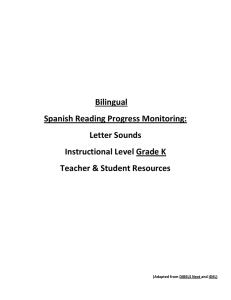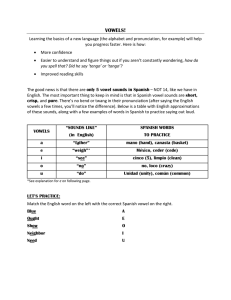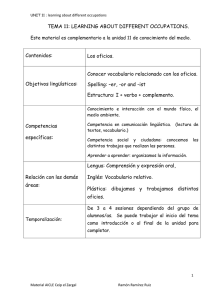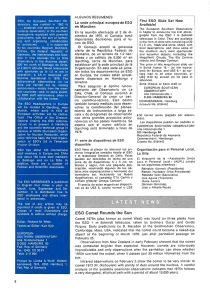Qualities of sound - Junta de Andalucía
Anuncio
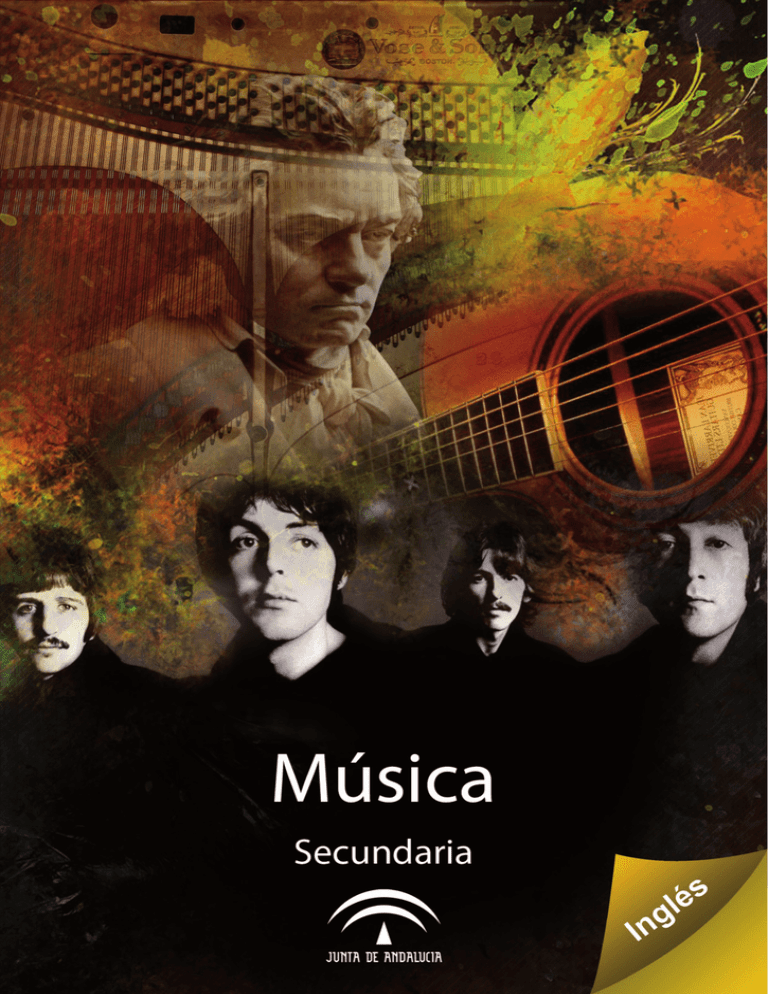
CONSEJERÍA DE EDUCACIÓN Dirección General de Participación e Innovación Educativa Identificación del material AICLE TÍTULO Qualities of sound NIVEL LINGÜÍSTICO SEGÚN MCER A2.1 IDIOMA Inglés ÁREA / MATERIA Música NÚCLEO TEMÁTICO Elementos de la Música GUIÓN TEMÁTICO La unidad pretende introducir al alumnado en las cualidades de los sonidos que nos rodean, incluyendo el silencio y el ruido, para luego aplicarlos a la música. FORMATO Material didáctico en formato PDF CORRESPONDENCIA CURRICULAR 1º de Educación Secundaria AUTORÍA Almudena Viéitez Roldán TEMPORALIZACIÓN APROXIMADA 5 sesiones. COMPETENCIAS BÁSICAS Competencia lingüística: - Adquisición de vocabulario - Elaborar y formular preguntas al compañero - Discusión y puesta en común en voz alta de aspectos concretos del tema - Extraer información de textos - Lectura comprensiva - Fomento de las destrezas orales Competencia en el conocimiento y la interacción con el mundo físico: - Aprendizaje de las cualidades de sonidos que nos rodean - Reflexión sobre la presencia de ruido y silencio en nuestra sociedad Competencia cultural y artística: - Partir de lo cotidiano para emplear esos conocimientos en aspectos más abstractos -Relacionar imágenes con palabras para entender su significado Competencia para aprender a aprender: - Uso de medios de grabación de audio o vídeo para el proyecto final OBSERVACIONES Se recomienda desarrollar esta unidad didáctica al principio del curso para dotar al alumnado de los conocimientos imprescindibles relacionados con la materia prima de la música, es decir, sonido y silencio, y sus cualidades. Material AICLE. 1º de ESO: Qualities of sound 3 Tabla de programación AICLE OBJETIVOS - Comprender y expresarse en una o más lenguas extranjeras de manera apropiada - Conocer, valorar y respetar los aspectos básicos de la cultura y la historia propias y de los demás, así como el patrimonio artístico y cultural - Apreciar la creación artística y comprender el lenguaje de las distintas manifestaciones artísticas, utilizando diversos medios de expresión y representación CONTENIDOS DE CURSO / CICLO Bloque 1: Audición. Bloque 2: Interpretación. TEMA - El sonido, la materia prima de la música - Sonido, silencio, ruido - Cualidades del sonido: altura, duración, intensidad y timbre MODELOS DISCURSIVOS - Comparar sonidos atendiendo a sus cualidades - Describir sonidos - Identificar palabras a través de sus definiciones - Describir paisajes sonoros - Contrastar opiniones - Buscar información en textos - Describir características, semejanzas y diferencias - Enunciar las cualidades de sonidos concretos TAREAS - Audición de diferentes sonidos del entorno - Identificar palabras e imágenes - Reproducción de sonidos atendiendo a sus cualidades - Vídeos de piezas musicales - Debates sobre la consideración de música, sonido y ruido CONTENIDOS LINGÜÍSTICOS CRITERIOS DE EVALUACIÓN 4 FUNCIONES: - Dialogar en parejas. - Justificar opiniones. - Mostrar acuerdo o desacuerdo. - Formular preguntas. - Dar y refutar opiniones ESTRUCTURAS: In my opinion… It is measured… It was supposed that… In turns There is no need.. It is related.. Conditionals: what would you think if you were…? Comparative: louder, shorter… The more…the louder… LÉXICO: Enviroment, sound, silence, noise, noise pollution, waves, vibration, concentric, regular, irregular, to measure, tidy, untidy, pitch, high, low, duration, intensity, loud, soft, timbre. Verbos irregulares: to say - Diferencia situaciones de sonido, silencio y ruido - Discrimina auditivamente sonidos graves y agudos, largos y cortos, fuertes y suaves - Identifica correctamente las cualidades del sonido de un sonido - Conoce el vocabulario específico relativo a las cualidades del sonido - Valora la importancia del sonido y el silencio como materia prima de la música - Reflexiona sobre situaciones de contaminación acústica Material AICLE. 1º de ESO: Qualities of sound CONTENTS 1. Introduction 2. Sound, silence, noise. 3. Elements of sound 3.1 Pitch 3.2 Duration 3.3 Intensity 3.4 Timbre 4. Review activity 5. Project Material AICLE. 1º de ESO: Qualities of sound 5 1. INTRODUCTION Work in pairs. Look at the following pictures. Describe each one, and imagine the sounds. Expressions to use: In Picture no. X I can see….. There are…..in picture X I think the sound in picture X is…….. In picture no. X you could hear…… 1 3 5 2 6 Material AICLE. 1º de ESO: Qualities of sound 4 6 2. With your partner, look at these pairs of pictures and say what they have in common. Use one word for each. Picture 1 - Picture 3: ……………………………….. Picture 2 - Picture 5: ……………………………….. Picture 4 - Picture 6: ……………………………….. 2. SOUND, SILENCE, NOISE. 1. Think of situations in which you would find sounds, silence or noise, and write them in the box. SOUNDS SILENCE NOISE 2. What is noise pollution? Talk about it with your partner, and talk about different situations which can create noise pollution. Expressions to use: Noise pollution is caused by… You get noise pollution when….. There is noise pollution in …. Material AICLE. 1º de ESO: Qualities of sound 7 3. Match these words with the pictures that describe them. - Wave - Vibration - Sound - Silence - Noise - Regular - Irregular - Concentric - To measure - Tidy - Untidy 8 Material AICLE. 1º de ESO: Qualities of sound We hear sounds all the time. All sounds are a form of energy produced by the vibration of an object. The vibration makes the air around the object vibrate too. These air vibrations are called sound waves. Sound waves travel outwards and bring the sound to our ears. Our ears send a message to our brain and we hear the sound. Sound waves are concentric – the centre is the object that produces the sound and the waves spread around it. So, if you are behind the object you can still hear the sound. Sound can travel through many different kinds of matter, including solids, liquids and gases. It travels at about 340 meters per second through air, but it goes faster through liquids and even faster through solids such as iron. Sound differs from noise in the way the waves are organized: sound waves are regular and tidy, while noise waves are irregular and untidy. 4. Answer the following questions: - What is sound?…………………………………………………… - What are sound waves?……………………………………….. ……………………………………………………………………… - Where does sound travel fastest?…………………………… - Why do you think we sometimes hear something before we see it (for example, an airplane)?.................................... ……………………………………………………………………… ……………………………………………………………………… Material AICLE. 1º de ESO: Qualities of sound 9 5. Is real silence possible? Try to be completely quiet for one minute. Write all the sounds you can hear - both inside or outside the classroom in the box below. Then, see if other students heard the same. Music is a combination of sounds and silence. Traditionally, noises were not part of music, but nowadays composers use sounds, silence and even noises in many different ways in their compositions to create new musical experiences. 10 Material AICLE. 1º de ESO: ………………………………………………… ………………………………………………… ………………………………………………… ………………………………………………… ………………………………………………… ………………………………………………… ………………………………………………… ………………………………………………… ………………………………………………… ………………………………………………… ………………………………………………… ………………… Qualities of sound John Cage, an American composer who explored the possibilities of sounds and silence in his compositions, was interested in silence. He wanted to experience absolute silence. He entered a soundproof chamber at Harvard University. It was supposed to be totally silent, but he heard two sounds. Later he discovered that these sounds were his heart beats. He discovered then that real silence is impossible while you are alive. One of John Cage’s most famous compositions is 4’33” (“Four minutes thirty three seconds”). In this composition, musicians don’t have to play any instruments. Watch this video. It is the performance of John Cage’s composition 4’33”. http://www.youtube.com/watch?v=hUJagb7hL0E Material AICLE. 1º de ESO: Qualities of sound 11 6. At the beginning of the video, the presenter introduces the piece to the TV audience. Here is the text, but there are some words missing. Try to fill in the gaps while you listen to the introduction. Cage wrote “Four minutes thirty three” as a piece in three movements but where the performers do absolutely nothing, allowing the audience to absorb the ………. around them, everyone experiencing the piece in a different way therefore, because we all ……… things in a different way. Tonight the piece is being presented in full orchestral version conducted by Lawrence Foster. He is going to give a down beat to each of the three movements, he’ll turn pages when he needs to, and of course the orchestra will remain …………- we hope - throughout the piece. I reckon Cage would be pretty pleased that this piece is being televised because of course you at …….. are going to experience this piece in a very different way of to those of us here in the hall. Well, I promise you, this is the piece everyone here tonight has come to experience. There really is nothing like John Cage’s “Four minutes Thirty three seconds”. 7. Watch the whole video. Look at the faces of the musicians, the conductor and the audience, and try to guess what they are thinking. What would you think if you were in the audience? 12 Material AICLE. 1º de ESO: Qualities of sound 8. Is this Art? Discuss with a partner. Is this composition “art” or not? Make a list of arguments for and against this idea to help you. Expressions to use: In my opinion… To me, this composition… I think this is…. FOR AGAINST 3. QUALITIES OF SOUND 1. Close your eyes for a moment and listen carefully. Write some of the sounds that you heard in this notebook. Material AICLE. 1º de ESO: Qualities of sound 13 2. How would you describe the sounds you have written? Here are some words to help you. First, have a look at the pictures on the right and try to match them with the words. Then, in the space below, use the words to describe the sounds. ....…………………… ....…………………… ....…………………… ……………………………………… ……………………………………… ……………………………………… ……………………………………… ....…………………… ....…………………… ....…………………… ……………………………………… ……………………………………… ……………………………………… ……………………………………… ....…………………… ....…………………… ....…………………… ……………………………………… ……………………………………… ……………………………………… ……………………………………… Every sound has qualities. These qualities relate to different aspects of the sound, such as the volume or the duration. There are four sound qualities: pitch, duration, intensity and timbre. 14 Material AICLE. 1º de ESO: Qualities of sound 3.1 PITCH 1. Look at the following groups of pictures. Can you guess what they have in common? All these sounds are ……….. sounds Material AICLE. 1º de ESO: All these sounds are ……….. sounds Qualities of sound 15 Pitch is the sound quality that distinguishes high sounds from low sounds. It is related to frequency, a scientific concept that tells us the number of vibrations per second of a sound wave. A scientific term for vibrations per second is Hertz, abbreviated Hz. A high sound has a lot of vibrations per second (a lot of Hz), while a low sound has few vibrations per second (not many Hz). This is how they would be represented: High sound Low sound 1 second The human range of hearing is limited (we cannot hear certain frequencies) and it goes from 20Hz to 25000Hz. Sounds with a frequency lower than 20Hz are called ultra-low sounds, while sounds higher than 25000Hz are called ultra-high sounds. Some animals can hear ultra-high sounds (for example bats), and other natural things like earthquakes create ultra-low sounds. In music, we represent the sound pitch with musical notes. 2. Complete the following sentences: - The sound quality that distinguishes high sounds from low sounds is called …………… - Humans cannot hear sounds of a frequency lower than…………Hz. - 25000Hz is the ……………… frequency humans can identify. - The frequency of a sound is the number of ………………………………………., and it is measured by ……….. - In music, we use the musical notes to say the …………. of the sounds. 3. How low/high is your voice range? In turns, try to make the lowest sound and the highest sound that you can. Remember! There is no need to shout!! 16 Material AICLE. 1º de ESO: Qualities of sound 3.2 DURATION Knock Knock Riiiiiiing¡¡¡¡¡ 1. We can find long sounds and short sounds. Think of a long sound and a short sound and tell your partner. Do you agree? Expressions to use: I think X is a long/short sound. Do you agree? I agree/ I disagree with you, because in my opinion… The quality of sound that refers to a sound’s length is duration. It distinguishes long sounds from short sounds. It is related to persistence, a scientific term that says how long the sound wave exists. It is measured in seconds. Long sound seconds Short sound It is really difficult to establish how “long” a long sound is (3 seconds? 20 seconds?) so it is always relative to other sounds. In music, we represent sound duration with note values. Material AICLE. 1º de ESO: Qualities of sound 17 2. Answer the following questions with a complete sentence. What is the duration of a sound? ………………………………………………………………………… ………………………………………………………………………… How many seconds does a short sound last? ………………………………………………………………………… ………………………………………………………………………… What is the scientific term for duration? What does it mean? ………………………………………………………………………… ………………………………………………………………………… 3. Everyone together. Take a looooooooong inhalation and make the longest sound that you can. Who can make the longest sound? Aaaaaaaaaaaaaaaaaaaaaaaaaaaa aaaaaaaaaaaaaaaaaaaaaaaaaaaaa aaaaaaaaaaaaaaaaa…….. 18 Material AICLE. 1º de ESO: Qualities of sound 3.3 INTENSITY 1. Look at the following groups of pictures. Can you guess what they have in common? All these sounds are ……….. sounds All these sounds are ……….. sounds Material AICLE. 1º de ESO: Qualities of sound 19 Intensity is the sound quality which relates to volume. It is also known as loudness. There are loud sounds and soft sounds. The scientific term for loudness is wave amplitude, and the measurement unit for the wave amplitude is the decibel, abbreviated dB. Soft sound Loud sound Sounds louder than 100 dB are painful for humans and a continuous exposure to loud sounds can damage the ear, causing hearing loss and even deafness. In music, we represent intensity with dynamics, these are Italian words used to express the different degrees of intensity. 2. Are these sentences true or false? - Humans can hear very loud sounds without suffering. - Intensity is the sound quality that refers to the volume. - We distinguish long and short sounds with intensity. - In music, we represent intensity with note values. - The measurement unit for intensity is Hertz. - The more amplitude a sound wave has, the louder it is. 20 Material AICLE. 1º de ESO: Qualities of sound 3. In turns, make a loud and a soft sound with your voice. Your teacher will organize the turns. 3.4 TIMBRE How can we distinguish the sounds of the different instruments? Timbre is the sound quality which makes it possible to identify the object that produces the sound. For example, we can distinguish a violin from a piano, even if they play the same sound with identical pitch, duration and intensity. Material AICLE. 1º de ESO: Qualities of sound 21 1. Close your eyes and listen. Your teacher will walk around the classroom and will touch different students on their shoulder. Those students have to say the word “TIMBRE” aloud. Try to guess who is speaking. 2. Close your eyes again. Your teacher will play the sound of some musical instruments. Try to identify them. 4. REVIEW ACTIVITY Listen to the different sounds that your teacher makes. After each one, fill in the following table. Write the name of the sound and identify its different qualities. SOUND 22 PITCH Material AICLE. 1º de ESO: DURATION Qualities of sound INTENSITY TIMBRE 5. PROJECT Work in 4 groups. Each group has to record atmospheres which represent sound, noise and silence (at least one of each). The recordings can be either video or audio. Then, each group will describe their atmospheres to the rest of the class, using vocabulary from the unit. Talk about the place where you recorded the atmosphere, and the qualities of the sounds that you hear. Expressions to use: We recorded this atmosphere in… This atmosphere represents… You can hear… The general pitch/intensity of the sounds of this atmosphere is… Material AICLE. 1º de ESO: Qualities of sound 23 AFTER THIS UNIT…. I CAN... Differentiate sound, noise and silent atmospheres YES NO NOT YET Identify the qualities of the sounds I hear YES NO NOT YET Classify the sounds I hear according to their sound qualities YES NO NOT YET Reflect on the excess of sound of some situations YES NO NOT YET Reproduce different sounds with different qualities YES NO NOT YET Express the qualities of sound in English YES NO NOT YET What sound is YES NO NOT YET How sound is produced YES NO NOT YET The difference between sound, noise and silence. YES NO NOT YET The qualities of sound and their characteristics YES NO NOT YET How to classify a sound according to its sound qualities YES NO NOT YET The vocabulary of sound qualities YES NO NOT YET I KNOW... 24 Material AICLE. 1º de ESO: Qualities of sound
